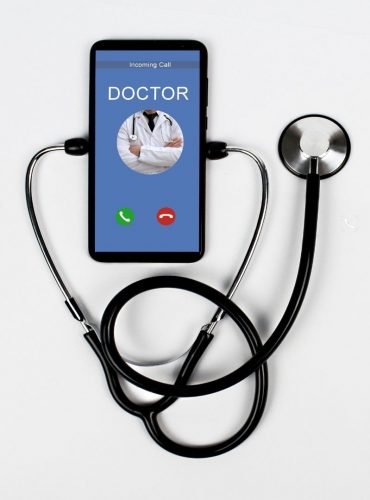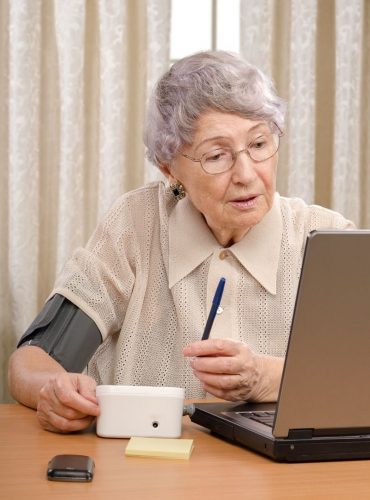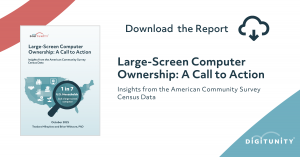This blog, the first in an occasional series written by Digitunity’s Health Advisor, Amy Sheon, highlights opportunities for disseminating digital inclusion-related resources through healthcare. The next blog in the series will discuss how healthcare can support digital health equity.
By Amy Sheon | December 8, 2021
Computers—The Gateway to The Growing World of Digital Health Technology
Computers and the internet should now be regarded as essential tools for managing health. On the most basic level, they offer access to “Dr. Google”—the ability to search online 24/7 for information about virtually every named health condition, or find support from others who may be experiencing the same odd collection of symptoms. But these tools also open the door to a rapidly expanding universe of devices, applications, and other technologies to maintain health and manage illness.
The COVID-19 pandemic, of course, led to a rapid shift of health care to the virtual realm to protect and patients and providers from exposure to the virus and to preserve then scarce personal protective equipment. Those who succeed in completing a telehealth visit are “overwhelmingly positive about their virtual interactions with their care providers.” Yet reports on telehealth utilization have consistently found disparities in use that reflect and reinforce health disparities.
Patients that live in low income neighborhoods, do not speak English, or are Black, Hispanic, or elderly were significantly less likely than others to have used telehealth during the first several months of the pandemic. Lack of internet, devices and skills have repeatedly been found to be barriers to telehealth use.
A recent national survey found that 38% of seniors were unready to use telehealth due to technology or physical barriers. More recently, it became apparent that these same vulnerable populations have been less likely than others to use telehealth. A common denominator in telehealth disparities, of course, is lack of computers, internet, and digital skills.
Schools, businesses, government, and non-profit organizations like Digitunity stepped up to begin closing these gaps. The $2.75 billion “Digital Equity Act” in the Infrastructure Bill will bring will bring millions more Americans online for the first time by expanding internet availability and offering device subsidies and digital skill training.
Once someone is digitally ready, a growing world of digital health technology awaits. This blog, the first in an occasional series written by Digitunity’s Health Advisor, Amy Sheon, highlights the hardware and connectivity requirements for using telehealth, and highlights the vast array of consumer technology that can support health and disease management.How Healthcare Can Support Digital Health Equity.
Telehealth: More than a Telephone Call!
Telehealth generally refers to a live two-way video visit between a patient and provider. To comply with federal regulations around data privacy, telehealth visits must be conducted over a secure platform. Many health systems use dedicated programs for this. Unlike popular video calling apps, these telehealth platforms may require the patient’s computer to use an up-to-date operating system, browser, and security settings.
There may also be requirements for the camera, microphone, and speakers that older devices would not meet. Some systems may require that patients have an email address and/or an active patient portal account to use telehealth. Patients thus may need considerable skills or assistance to configure their device and internet settings and to navigate to the link.
All in all, while telehealth offers a level of convenience that is likely to be especially welcome to people facing financial or mobility barriers to in person appointments, these same populations may be least able to access telehealth due to gaps in devices, connectivity, and digital skills.
Device & Connectivity Considerations for Telehealth
Desktop computers have several advantages for telehealth. Most have a large screen, which enables the patient to see the provider clearly. Seeing the provider up close enables patients with hearing loss to read lips. Watching the provider talk may also help if the audio quality is poor.
However, in general, the sound quality on a fixed device is likely to be superior to that on smaller devices. Desktops also usually have full size keyboards. These can be especially helpful if the patient is asked to complete a form, submit a question, or navigate to a specific website.
Because they are easily moved, laptops enable a patient to find a well-lit private location for the visit, possibly even away from their own home if they lack internet or privacy. Being able to easily reposition the device also enables a provider to see something on the body up close, or to visualize the patient’s environment. This can be helpful, for example, for patients undergoing rehab after surgery and needing assistance with how to navigate steps or getting out of a chair.
Smartphones, of course, can be used from nearly anywhere, either over a cellular or wi-fi connection. However, their small screens and keys make these devices far less functional for a telehealth visit, especially among older patients who are more likely to have eyesight and motor control barriers.
Tablets are an intermediate solution with slightly bigger screens and keyboards, plus portability. However, tablets may not have the software needed for a telehealth call, and the sound quality may be limited. Smaller devices like tablets and smartphones are more vulnerable to loss, theft, or damage; and use of wi-fi connections outside of the home can raise data security risks.
An internet connection is required for telehealth. This could be a fixed broadband connection to a household or a mobile connection that can be used with a computer via a wi-fi hotspot, or used directly on a smartphone. As a general rule, a fixed broadband connection will be faster and more reliable than a mobile connection.
While the bandwidth requirements vary by telehealth platform, a reasonable benchmark is the current FCC standard for broadband service: 25 megabits per second (Mbps) download and 3 Mbps upload speed. With telehealth looking like it’s here to stay, the value of connectivity for health is beyond question. Thanks to rapid developments in health technology, the importance of digital readiness will only become more significant over time.
Several companies have introduced home kits with connected components that enrich the telehealth visit. With the patient (or a helper) positioning an optical viewing or listening device, for example, their provider can see real-time images of the patient’s throat, nasal passages, and ears on their monitor, and listen to their heart and lungs.
Beyond Telehealth: Computer Superpowers
Whether or not a computing device can support telehealth, if it can go on the internet and has a display and keyboard, it has a superpower: enabling a patient to access their electronic health record portal through a website, a webapp, or a smartphone app. Portals offer unparalleled (if underappreciated) value for managing health and health care.
MyChart, by Epic, is the most widely used portal. It offers dozens of functions such as displaying lab test results, diagnoses, and medications; providing reminders when preventive care measures such as mammograms are due; requesting or scheduling an appointment, and exchanging non-urgent messages.
MyChart and some other portals offer trustworthy information on virtually every health condition imaginable, plus provide the ability to find a provider treating a specific condition. Patients can upload information such as photographs or vital signs for their provider to review, request medication refills, download their records, and share their records with other providers.
Parents can manage their children’s information, while others can give permission for a trusted care giver to access their portal to assist with their care. Some people find portals easier to navigate on a smartphone app than a computer, but some portals offer only limited functions on the app. In addition, many will find larger displays and keyboards on a desktop to be helpful for using portals, especially if viewing documents or entering text information.
Computers as the Gateway to the Consumer Health Technology Revolution
Computers that can support a telehealth visit contain several components that open the door to a plethora of other health technology. By listening to and analyzing the patient’s voice or surroundings, microphones on computers or smartphones can alert consumers to recurrence or worsening of a condition such as depression.
Ambient noise can be used to measure sound decibels for hearing protection, monitor sleep, or stream sound to a hearing aid when amplification is needed. Applications that convert audio input to text can be useful for persons that lack hearing or who need translation services.
Dictation to transcription is a quick way to enter information into online forms. This is especially useful when using devices with small keyboards, for those with physical barriers to typing, or when the spelling of a word is not known.
Still photos captured by computers’ cameras can be uploaded to a server where a dietician can estimate the nutrition content of a meal or artificial intelligence used to determine the likelihood that a skin lesion or wound needs medical attention.
The camera can also be used to confirm a patient’s identity, such as might be needed for a patient to provide consent for participating in a research study. Speakers and video display can be especially useful for training health care providers (e.g. in surgical techniques) and consumers/patients (e.g. for fitness or rehabilitation exercises).
Both desktops and smartphones use geolocation information to enable consumers to search for things nearby or in a specific geographic area such as healthcare providers, farmer’s markets, or an open recreation center.
De-identified, aggregated geolocation data from smartphones can help public health authorities and researchers to monitor adherence to social distancing, or to identify areas where residents lack convenient access to safe spaces for outdoor recreation.
Smartphones and wearable devices use triaxial accelerometers to track left-right, forward-backward, and up-down movement. Once uploaded via Bluetooth or USB to a computer and server, movement data is processed to detect and summarize physical activity and sedentary time, assess a person’s gait, detect a fall or risk of falling, and monitor posture.
Connected Devices
Home blood pressure cuffs and glucose meters have been available for decades to help patients manage their blood pressure and diabetes. However, having a computer and internet connection opens the door to using a newer generation of devices that process information in the cloud, and then display results on a computer or smartphone.
These connected monitors offer the potential for even better disease control because patients can also input and track other information such as food, medication or symptoms, explore patterns in their data, and share the data with their doctor through the patient portal.
It seems that every day brings a new biometric monitoring device that connects to a computer, such as a device about the size of a business card that enables patients to generate an ECG cardiac reading that is reviewed promptly for urgent or important anomalies.
With appropriate instruction and medical supervision, patients should feel confident in using devices that are prescribed by a physician and covered by insurance. However, dozens of other types of connected devices and software applications are available directly to consumers, with varying degrees of quality. Some examples are described below, followed by tips for making wise purchasing decisions.
Biometric Monitoring and Disease Management
- Connected pill bottles can remind people to take their pills, alert them to refill prescriptions, and summarize medication usage on a weekly or monthly basis.
- Breath sensors can determine whether blood alcohol levels are within legal limits for driving, or measure fitness during a controlled activity.
- Skin sensors can measure hydration or caloric expenditure.
- Clothing sensors can monitor concussion risk, posture, or detect falls.
- Blood oxygen sensors can monitor exercise intensity, provide early detection of impaired breathing requiring medical attention (COVID-19), or alert a parent if an infant is in distress.
- Connected thermometers can help women monitor their menstrual cycles and enable parents to track their children’s illnesses. By distributing thermometers to families, schools have been able to identify infectious illness trends and take prompt action to reduce absenteeism. One company has used data from millions of connected thermometers to predict the emergence of COVID risk based on the abnormal fever patterns associated with the disease.
- Environmental sensors that detect worrisome atmospheric conditions trigger apps that alert patients to use their asthma medications. Conversely, computer servers detecting inhaler use among multiple people in defined geographic areas can give early warning of risky atmospheric conditions.
What Types of Connected Medical Devices can be Trusted?
Consumers should use due diligence before adopting a digital health tool such as a medical device that would connect to a computer. First, note if the U.S. Food and Drug Administration (FDA) has assigned a “Class” to the device.
The Class is based “on the intended use of the device and also upon indications for use.” The Class also reflects the level of risk to the patient with a I assigned to devices that present little risk to human health and II assigned to devices that sustain life and/or present a risk of serious injury or death.
Computers and smartphones themselves are not considered medical devices, but some applications that use them are. Note whether your intended use of the device is consistent with how it was reviewed by the FDA.
Next, see whether the device is listed as “Registered,” “Cleared,” or “Approved” by the FDA. All medical devices must be Registered, but that designation does not imply quality control or FDA approval. Low-risk devices can be “Cleared” by demonstrating that the product is similar to other cleared products.
Devices that are implanted or applications with the potential for substantial benefit or harm must undergo the rigorous approval process that requires strong evidence that the product is safe and functions as intended and described.
Check product packaging or the FDA to find out regulatory approval status. Software and products that are intended “for maintaining or encouraging a healthy lifestyle and is unrelated to the diagnosis, cure, mitigation, prevention, or treatment of a disease or condition” is not regulated by the FDA at all.
Check product websites for partnerships with academic institutions and published research studies that showed the product’s effectiveness. Look as well to see whether diverse populations were included in product development and testing.
Disparities in Telehealth Remain
While most people have access to some device connected to the internet, data that continue to show disparities in telehealth use remind us that much work remains. Groups like Digitunity play a vital role in ensuring that everyone has a computer that is capable of supporting telehealth and connecting to other health technologies.
Elsewhere, I have highlighted efforts around the country to close connectivity and digital literacy gaps. My next Digitunity blog will review measures being taken by health systems and community organizations around the country to increase digital health tool adoption among those who stand to benefit the most.
About the Author
Amy Sheon has 30+ years’ experience working on emerging public health challenges and cutting-edge solutions. She recently served as Senior Fellow at the National Digital Inclusion Alliance, and is the Research Director for the Telehealth Equity Coalition.
Through her consulting firm, Public Health Innovators, LLC, she provides digital health equity consultations to leading health systems, non-profit, academic, and government organizations. Her most recent publication is “Digital Inclusion as a Social Determinant of Health.”





